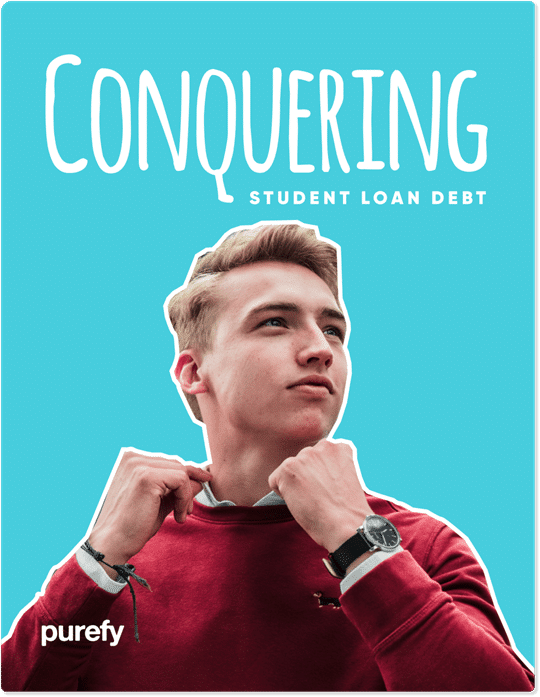Student loan refinance interest rates hit a record low in 2021, thanks in part to the Federal Reserve slashing its interest rate to near zero at the beginning of the coronavirus pandemic.
The “Fed” began raising interest rates in 2022 and will likely continue in 2023, which can impact interest rates on new refinance loans and existing refinance loans with a variable interest rate.
If you want to better understand how the Fed increasing interest rates can impact you, here’s everything you need to know.
What is the “Fed?”
The Fed is a nickname for the Federal Reserve, which is the central bank for the United States. It’s made up of 12 regional Federal Reserve banks that serve different geographic regions in the U.S., and it provides a lot of services for the country, including:
- Supervising and regulating banks
- Managing inflation
- Maintaining financial stability for the country
- Providing banking services to other banks, the U.S. government, and foreign banks
The Federal Reserve was created in 1913 after the Panic of 1907, the first global financial crisis of the 20th century. Today, the Fed is guided by its Board of Governors, which is composed of seven members.
One way the Federal Reserve helps manage inflation and maintain financial stability for the country is by adjusting its federal funds rate.
The federal funds rate is the interest rate at which banks borrow from and lend to each other on an overnight basis to meet cash reserve requirements set by federal regulators. This interest rate is closely linked to what’s called the “prime rate,” which is what banks, credit unions and other lenders use to calculate short-term interest rates.
When the Fed cut its interest rate to near zero in March 2020, interest rates for certain loans, including private student loans and student loan refinance options, and credit cards followed suit.
How does the Fed calculate interest rates?
The decision for the Fed increasing interest rates is determined by the Federal Open Market Committee (FOMC), which is made up of the seven members of the Board of Governors and five of the 12 Federal Reserve bank presidents.
The FOMC meets eight times a year to summarize its economic outlook for the U.S., as well as policy decisions. One of those decisions may be to raise or lower the federal funds rate.
The decision for determining what the interest rate should be is based on the economic outlook of the committee and whether it needs to make changes to the rate to influence economic growth.
For example, when the coronavirus pandemic hit the U.S., the economy came screeching to a halt. Tens of millions of workers applied for unemployment benefits, and hundreds of thousands of small businesses closed for good.
As a result, the Fed slashed its interest rate to near zero for the first time ever to help encourage economic growth. When the federal funds rate and, therefore, lender rates are low, consumers are more likely to borrow money, increase spending and engage in other economic activity to help boost inflation and the economy.
When inflation starts to get out of control, the Fed increasing rates may result in less borrowing and lower spending, which can help keep inflation within certain bounds.
So if the question is how exactly the Fed calculates its interest rate, the answer is: it’s complicated.
The 2 Best Companies to Refinance Student Loans
Our Top-Rated Picks for 2024 Offer Low Rates and No Fees

Why is the Fed raising rates in 2023?
The decision to continue increasing interest rates is largely due to recent inflation. The Fed keeps an eye on various inflation indicators, such as the Consumer Price Index and the Producer Price Index, to understand the overall health of the economy.
While inflation can be a good thing because it signals a strong economy, inflation that increases too quickly could have the opposite effect and throw the country into an economic spiral.
The annual inflation rate has been 5% or higher from May through September, according to Trading Economics. In contrast, the inflation rate was just 1.2% in 2020.
By increasing the federal funds rate, the Fed may succeed in helping slow the growth in the economy’s inflation rate, which could help slow the rise in the cost of consumer goods and other products and services.
What might interest rates in 2023 look like?
It’s still unclear how high the Fed will raise rates in 2023. While officials and experts can speculate on what they believe the FOMC might do, we won’t actually know what will happen until it happens.
Some, for instance, have guessed that the Fed might increase interest rates more than once. In one CNBC article, the director of rates at Wells Fargo stated that the company had priced in 0.58% in rate hikes in its expectations for the stock market.
But again, there’s no way to tell for sure until we hear it from the Fed.
What do interest rate increases mean for student loan borrowers?
If the Fed decides to increase interest rates next year, it may or may not have an impact on your student loans. Here are a few different scenarios and how it might impact you.
You’re a college student
If you’re still in school, you’ll likely need to take out student loans at some point before you graduate. If you only borrow federal student loans, the Fed increasing rates likely won’t impact you. Congress sets the interest rates for federal student loans, and the legislative body typically uses the 10-year Treasury note to determine the annual rate.
That said, if you might need private student loans at some point in the future, the Fed raising rates could result in those rates being higher than if you were to apply for the loan right now.
You’re paying off fixed-rate student loans
If you or your child has graduated from college and your student loan interest rates are all fixed, the federal funds rate will have no impact on your current loans. Because you chose fixed-rate loans, they truly stay fixed for the life of the loan.
You’re paying off variable-rate student loans
Variable interest rates may be tempting because they typically start out lower than fixed interest rates. But over time, they can increase as the prime rate increases — and you’ll remember that this rate is influenced by the federal funds rate.
As a result, if the Fed hikes its interest rate, you’ll likely see an increase in your rate as well, which will also increase your monthly payment.
Keep in mind, though, that lenders typically set limits on how much your interest rate can go up in a year and overall. But if you have variable-rate loans, it’s definitely worth thinking about refinancing your debt and converting it to a fixed-rate loan.
You’re thinking about refinancing
Regardless of the type of loan and interest rate you have now, if you’re thinking about refinancing, it may be a good idea to start the process sooner rather than later. Even without a change in the federal funds rate, student loan refinance interest rates have been creeping up throughout the year.
If you wait too long, it’ll be more difficult to get a loan with a low enough interest rate to make refinancing worth your while. Even if you do still qualify for a lower rate than you have now, you may be leaving savings on the table by waiting.

Free eBook: How to Conquer Student Loans
Free eBook: How to Conquer Student Loans

Will student loan refinance rates go up in 2023?
There are a lot of factors that go into determining an interest rate on a student loan refinance. One of those factors is the prime rate that lenders use as a benchmark to determine their interest rates.
If the prime rate continues to rise in 2023 in response to the Fed increasing its federal funds rate, then you can expect student loan refinance rates to also increase. It may not necessarily increase at the same rate as the Fed’s interest rate, so there’s still a measure of uncertainty.
But again, if you’ve recently been thinking about refinancing your student loans, then it might be worth it to think about pulling the trigger on applying in the near future.
Should I refinance my student loans?
There are good reasons to consider refinancing your student loans, but there are also good reasons to think twice before you go down that path. Here are some of the biggest benefits of refinancing your student debt:
- You could save money: If your credit score and income are in good shape — or you have a cosigner with those attributes — you could potentially save money through a lower interest rate. Additionally, student loan refinance companies offer shorter repayment terms than what you could get with the federal government, so if you can afford a larger monthly payment, you could save money by paying off your debt sooner.
- You could get a lower monthly payment: For people who refinance with a lower interest rate, a lower monthly payment may come naturally. But you’ll also have the option to extend your repayment term to up to 20 years with some lenders. This will mean more interest charges over the life of your loan, but if your budget is tight, it may be worth it for the payment relief.
- You could choose your lender: When you first took out federal student loans, you didn’t get to choose your loan servicer. And if you consolidate, you could choose your servicer, but you’ll also end up with a slightly higher interest rate that way. What’s more, private lenders are generally willing to provide more benefits to their borrowers than federal loan servicers with a guaranteed contract. That said, you may be wondering what you’re giving up if you decide to refinance your student loans. Here are some of the top drawbacks to keep in mind as you think about which direction to go:
- You’ll lose federal benefits: If you’re refinancing federal student loans with a private lender, you’ll lose access to certain benefits that private lenders simply don’t offer. That includes loan forgiveness programs and income-driven repayment plans. Loan forgiveness programs could save you thousands or even tens of thousands of dollars. And if you anticipate financial hardship in the future, it might be worth it to hang onto your loan simply for the income-driven repayment options.
- You may not qualify: While many tout the benefits of refinancing, it’s important to understand the reality of the situation. More specifically, you may not qualify to refinance your loans. Even if you do, the best loan terms are reserved for people with high credit scores and high incomes. In other words, you may end up disappointed.
- Not all lenders allow cosigner release: One way to get past the potential roadblock of eligibility is to ask a loved one to cosign your application to refinance your student loans. Keep in mind, though, that while some lenders allow you to release your cosigner from the loan after you make a certain number of consecutive on-time payments, that’s not always the case. Even if you have the opportunity, you’ll still need to qualify for the loan on your own, and if your income and credit haven’t improved enough, your cosigner may be stuck with the loan on their credit report for a long time.
You may also be wondering if you should hold off on refinancing in the event that President Joe Biden offers broad student loan forgiveness.
The president proposed to offer $10,000 in forgiveness across the board as part of his coronavirus stimulus package, but it didn’t happen. The president even instructed his Education Secretary to prepare a memo to discuss his legal options as the chief executive, but the White House has yet to provide any information about what was in the memo several months later.
So while widespread forgiveness may not necessarily be completely out of the question, it may not be worth it to make significant financial decisions based on something so uncertain.
See How Much You Can Save
View Details
Collapse
Step 3: See How Much You Can Save
$15,310
Lifetime Interest
Savings
$1,018
New Monthly
Payment
$128
Monthly
Savings
| Current Loan | New Loan | Savings | |
|---|---|---|---|
| Rate | 6.7% | 4.2% | 2.5% |
| Lifetime Interest | $37,520 | $22,210 | $15,310 |
| Monthly Payment | $1,146 | $1,018 | $128 |
Like what you see? Check your actual prequalified rates from the industry’s top lenders in just 2 minutes or less.
How to refinance student loans now, while rates are at all-time lows
While student loan refinance interest rates have increased since the beginning of the year, they’re still near their all-time lows, so now is an excellent time to consider refinancing your student debt.
Here are some steps you can take to get the process going and to ensure that you find the best deal:
- Decide if it’s right for you: Take a moment to consider both the pros and cons of student loan refinancing and how they fit into your specific situation. There’s no one-size-fits-all answer here, so it’s important that you know your current needs and future goals to make the best decision for you.
- Research lenders: Shopping around is one of the best things you can do to make sure you find the best deal. Each lender has its own criteria for determining eligibility and interest rates, so one lender may be able to offer you a lower rate than others. You’ll also want to look at other features and benefits a lender might offer to make the right decision.
- Get rate quotes: Student loan refinance lenders typically allow you to get prequalified before you apply, so you can get an idea of what interest rate you might qualify for if you were to submit an application. Make sure you get rate quotes from several lenders, so you can easily compare.
- Choose a lender and your loan terms: After you’ve done your research, you’ll want to settle on a lender and think about what terms you want. For example, do you want a fixed or variable interest rate? How long do you want your repayment term to be? Think about how you want to construct your new loan for maximum effectiveness.
- Submit your application: Once you’ve made all of your decisions, submit an application to the lender of your choice. You’ll typically need to provide some basic information about yourself, as well as your existing loans. You’ll likely also need to provide various documentation, such as proof of graduation, proof of income, proof of residency, a government-issued ID and more. The faster you submit your documents, the more smoothly the process will go.
- Review the final offer and sign the agreement: Once you’ve submitted an official application, the lender will run a hard credit check and give you a final offer based on what it finds. This may differ slightly from the initial rate quote, but it’s typically not a huge difference because a soft credit check provides enough information to get a bead on your credit health. If you want to accept the offer, you’ll e-sign the paperwork and complete the loan.
- Keep making payments: While you’re waiting for your new lender to pay off your loans with your old loan servicers, it’s crucial that you keep making your monthly payments as usual. This process can take some time, and the last thing you want is to watch your credit get dinged because you thought it would happen sooner and didn’t make any more payments. If you end up overpaying your old lender, you’ll get a refund check in the mail.
How to compare historic low refinance rates and lock in your best quote
Shopping around and comparing quotes is the best way to secure a low interest rate on your refinance loan. However, taking the time to get prequalified with each individual lender can be time-consuming, and it can be frustrating having to enter the same information over and over again.
Fortunately, there’s a way to compare multiple lenders side by side with just one prequalification tool. The Purefy Compare Rates tool allows you to view multiple loan offers based on your credit profile to help you make the best decision about your student loans.
As you go through the process, make sure you’re comparing apples to apples. Remember, variable interest rates typically start out lower than fixed interest rates, so they’re appealing. But if you pick a variable rate and market rates increase, you may end up paying more in the long run.
Also, make sure you visit each lender’s website to get more information about what they offer in terms of features and benefits. This can give you a better idea of which lender is the right one for you, especially if a lot of your rate quotes are similar.
Finally, don’t forget that prequalification typically only requires a soft credit check, so none of this will impact your credit score in any way. Once you submit an official loan application, though, there will be a hard credit check involved.
The bottom line
The Fed increasing rates in 2023 can have an impact on you if you’re currently a college student or a graduate or parent with variable-rate loans. What’s more, if you think you might ever consider refinancing your loans, an increase in the federal funds rate will make it more difficult for you to maximize your savings.
As a result, it’s a good idea to at least do some due diligence on whether refinancing is right for you and how much it can save you. As you compare your options, use a student loan refinancing calculator to get an idea of how much you can actually save based on your current loans and eligibility.
While there’s no guarantee that refinancing will save you money or work for you in the long run, the important thing is to take the time to research how to best tackle your student loan debt. Even if you decide not to refinance, you’ll likely learn enough to make the decisions you need to make the most of your student loans.



















